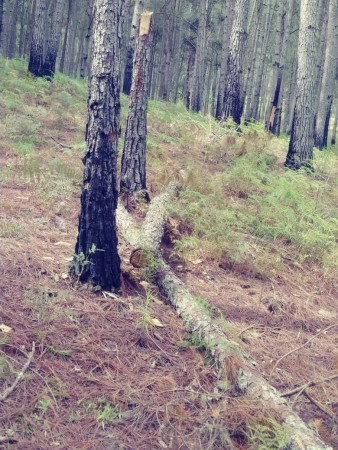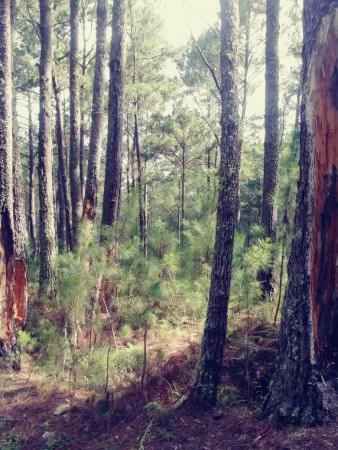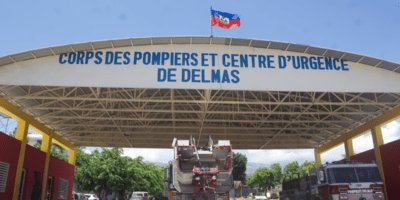The place is under urgent threat
The « La Visite » park, located in the southeast in the Selle mountain range, contains a forest important for its biodiversity and is home to the largest pine reserve in Haiti. The site, which is part of the La Selle Biosphere Reserve, according to a UNESCO designation in 2012, was declared a protected area in 1983.
However, the park « La Visite » is under constant threat. Nearly 800 families live there and turn the space into a site of beds and crops. As a result, the water sources fed by this forest reserve are drying up, fires and the systematic felling of trees reign supreme.
« Forests are under great threat in Haiti, » says Prenord Courdo, head of the National Agency for Protected Areas (ANAP). The precarious conditions in which communities in the country live sometimes force people to cut down trees in order to ensure their survival.
Haiti has 25 protected areas, including eleven marine areas and fourteen terrestrial areas. These geographical areas are recognized by the State in order to ensure the conservation of their ecosystems and natural resources.
The park is considered one of the last remaining forest reserves in Haiti. It has a great richness in terms of its flora. Plant species shelter the space and several varieties of birds colonize its environment.

La visite Parc, haiti
Repeated fires
The Park’s first threat comes from fire. « Bad practices have been observed for ages in the forest, » reveals Exequiel Sémé, a civil engineer and initiator of a petition for the urgent safeguarding of the La Visite National Park. We are witnessing most of the fires that have been reported in La Visite Park, » he said.
Agronomist Courdo reports that fires in Haiti’s forests are a common practice. « Very often, some families voluntarily choose to set fire to create agricultural spaces, » he confirms. The firewalls and forest guards placed by the ANAP are powerless.
Read also: Road announced at Morne l’Hôpital will be a disaster for P-au-P, experts predict
In 2013, there were 31 crossing guards in charge of La Visite Park. The Ministry of the Environment had found that the region was under threat. The initiative did not last after a year. Today, there are only three crossing guards responsible for the management of 11,426 hectares of land at risk.
This is a global problem. « The protected areas brigade has about 200 officers, » according to the ANAP DG. These officers are usually insufficient in number to manage these spaces, which generally extend over rather large areas.

The pine forest is located in La Visite National Park. It is one of the last remaining forests in Haiti, a country where deforestation is rampant
The pressure exerted on the environment by the hundreds of families who live in the Park comes with dramatic consequences.
The water table of the Massif de la Selle feeds almost all water sources in the West and South-East departments. The trees of Parc La visite and Furcy (extension of Parc La visite in Kenscoff) placed on the heights of the Selle serve as a feeding area for the main rivers and springs of the country.
« The runoff water from the Léogane gullies, the Froide River, the Momance River and the Grise River are constantly fed by the Parc La visite watershed, » according to Prenord Courdo. The flow of these rivers is now reduced with the abusive construction of houses in this reserved area and the aggressive felling of trees.
Read also: Bandits profit from illegal sand mining in Morne l’hôpital
« Trees help fill the aquifer when it rains, » says Dominique Francisque, head of watersheds at the Ministry of Agriculture, Natural Resources and Rural Development (MARNDR).

La visite Parc, haiti
Therefore, the more trees there are in the watersheds, the more the water table is fed by water infiltration. At the same time, the more houses there are, the higher the risk of runoff and the springs capture less water.
Agronomist Courdo points to the climatic phenomena that have caused a major drought in the country as another factor explaining the decrease in the flow of springs. « Our forests haven’t received the amount of rain they should necessarily receive. »
When rain falls, which is rare, it comes with force and the soil doesn’t have time to infiltrate the water table, Courdo adds. The runoff of this water is causing great damage in the neighborhoods located at the foot of the Massif de la Selle, according to Janis Simon, a former forest ranger of the « La Visite » park.
The need for support
The latest figures on Haiti’s forest cover are from 1999. Although the 2% figure mentioned by several NGOs is exaggerated according to experts, the situation remains serious.
Since the environment has no owner, the director of ANAP, Prenord Courdo, believes that it is necessary for every citizen to collaborate in the protection of trees and the management of natural resources.
However, the poverty of the population is an obstacle to environmental awareness. The multiple campaigns carried out in the La Selle Biosphere Reserve are not yielding the expected results. Courdo acknowledges: « Awareness goes hand in hand with purely economic actions in order to make it easier for people to have a means of survival without having to rely on the resources of La Visite Park. »
English translation by Sarah Jean.
Photos by Exequiel Semé.
Keep in touch with AyiboPost via:
► Our channel Telegram: click here
► Our Channel WhatsApp: click here
► Our Community WhatsApp: click here







Comments